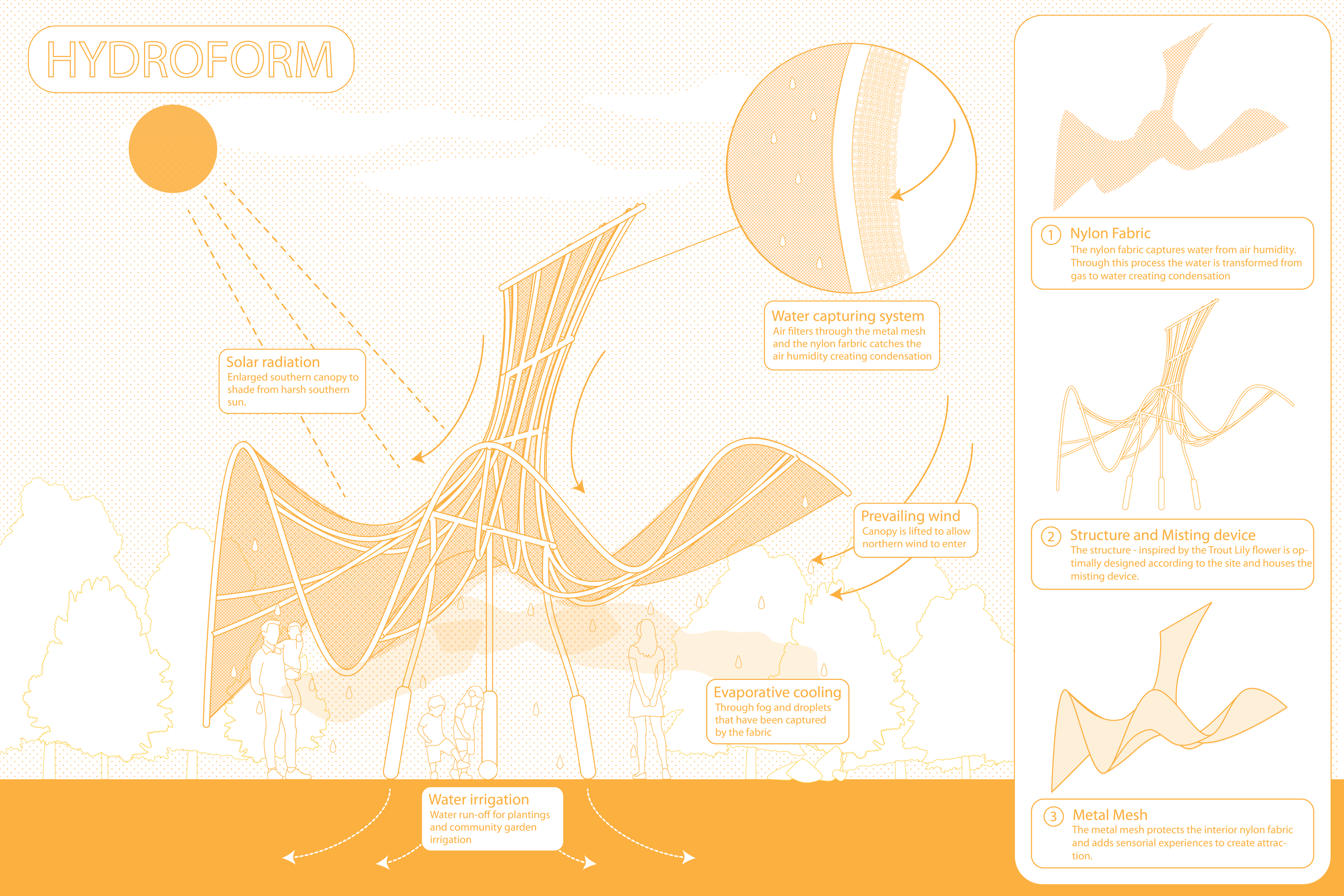RAIN BLOOM PUBLIC CANOPY
How can a public canopy celebrate water retention infrastructure?
The Rain Bloom Public Canopy is our proposal for a sculpture that dramatizes the ongoing work of capturing stormwater. Inspired by the endangered native perennial flower, the sculpture highlights the stages of water, its importance to a vibrant ecosystem, as well as its beauty and ephemerality.
The installation integrates a unique water collection system, using polyester mesh to condense atmospheric moisture into droplets, which are directed towards the legs of the structure. This harvested water can then be used to irrigate the adjacent community garden. Set within a thoughtfully designed landscape area, the Rain Bloom Public Canopy is a gathering space for all kinds of events and programming, and a space where people can connect to nature and to each other. At night, the sculpture can be lit up to highlight the glinting mesh, and can begin to take on different hues to reflect the changing quality of light in the night sky.
Location: Richmond, VA
Year: 2023
Client: City of Richmond
Service: Landscape architecture, canopy, pavilion, hydrology
Firm: Terreform ONE
Bringing awareness to the constructed water retention areas, the artwork creates a gathering place for visitors to relax and cool down, celebrating water in its different states and enhancing the people of Richmond’s access to the wonders of natural systems.
Placemaking: Located amidst the bioretention ponds, community center, and grove, our site offers a serene atmosphere to sit within a lushly planted landscape.
The installation showcases the water cycle of the bioretention ponds while also serving as a prominent beacon for drivers approaching the community center. It harmoniously blends art, nature, and community, creating an alluring destination that sparks wonder and curiosity.
Community
Serving as a central outdoor gathering space, the beacon brings the community together. Whether it’s a break between baseball games or a family taking a leisurely walk, the installation fosters connections and shared experiences. With its inviting design and atmosphere, it creates a sense of belonging and togetherness, encouraging interactions and the formation of new relationships. It stands as a testament to the power of shared spaces in enriching the lives of the community members.
Performance
This project harvests water from the atmosphere using specific mesh materials while engaging users through interactive misters. Beyond its practical applications, it also serves as an educational tool, showcasing the water cycle in action. By demonstrating the collection and transformation of moisture into a valuable resource, it offers a unique and immersive learning experience, fostering a deeper understanding and appreciation for water conservation. This innovative installation bridges science, art, and user engagement, inspiring environmental consciousness and promoting a greater understanding of the intricate processes that sustain our ecosystem.
TROUT LILY - ERYTHRONIUM AMERICANUM
The Trout Lily, an endangered perennial native to the eastern United States, is a remarkable plant that thrives beneath the shade of the forest canopy. When the leaves of the trees have fallen and the early spring sun can penetrate to the forest floor, the Trout Lily emerges, expanding its wings to take in the warmth. Each morning it opens up, and closes once again with the falling light, protecting itself from the cold. Once it reaches maturity, its stamens absorb moisture from the atmosphere, causing it to become topheavy and allowing gravity to pull itself upside down. In doing so, it protects itself and its seed load from the elements, and creates the conditions for insects to disperse its seeds. The design of the AquaFlora Public Canopy draws inspiration from the beauty of the Trout Lily flower. Its graceful form serve as a design reference, and its relationship with water, moisture and protection form the basis of our proposal. By incorporating elements that condense atmospheric moisture, collect water, and provide a canopy-like structure, we aim to reflect the Trout Lily’s resilience and its intrinsic connection to water in our design.




